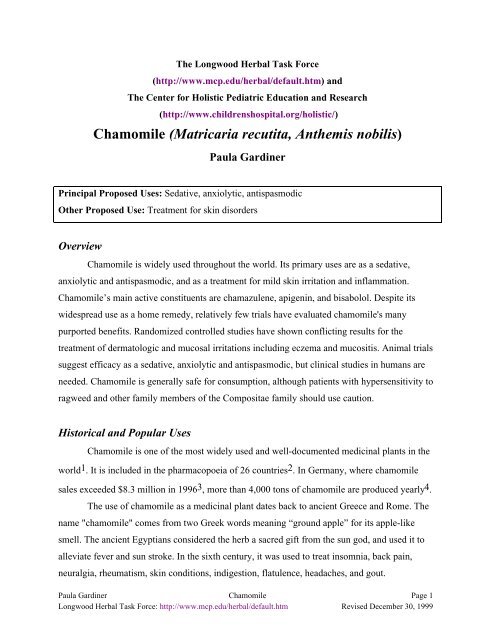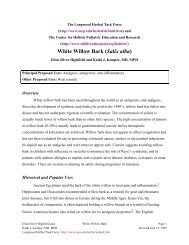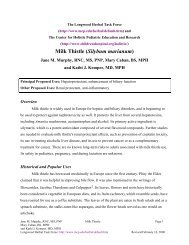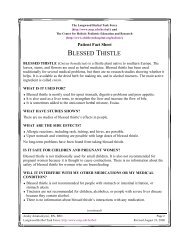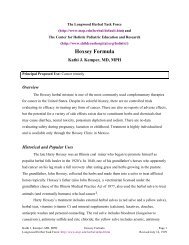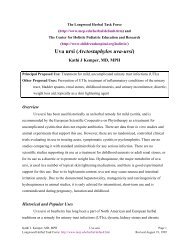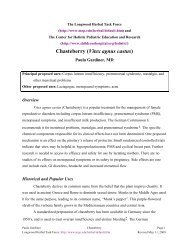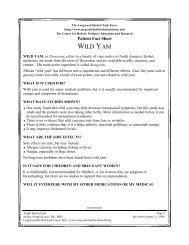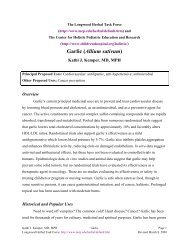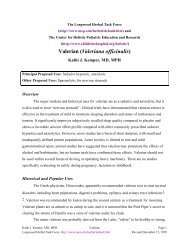Chamomile (Matricaria recutita, Anthemis nobilis) - Longwood ...
Chamomile (Matricaria recutita, Anthemis nobilis) - Longwood ...
Chamomile (Matricaria recutita, Anthemis nobilis) - Longwood ...
You also want an ePaper? Increase the reach of your titles
YUMPU automatically turns print PDFs into web optimized ePapers that Google loves.
In Europe it is considered a “cure all”, and in Germany it is referred to as “alles zutraut”,meaning “capable of anything” 4 . Although there are numerous varieties of chamomile, the twomost popular are Roman chamomile (<strong>Anthemis</strong> <strong>nobilis</strong>) and German chamomile (<strong>Matricaria</strong><strong>recutita</strong>); both are from the Compositae family. German chamomile is considered the morepotent of the two, has received more scientific evaluation, and is more widely cultivated thanRoman chamomile; it is believed to possess anti-inflammatory, vulnerary, deodorant,bacteriostatic, antimicrobial, anticatarrhal, carminative, sedative, antiseptic, and spasmolyticproperties 5 , 6 . Roman chamomile is believed to possess carminative, antiemetic, antispasmodic,and sedative properties 5 .<strong>Chamomile</strong> is used both internally and externally to treat an extensive list of conditions.It is used externally for wounds, ulcers, eczema, gout, skin irritations, neuralgia, sciatica,rheumatic pain, hemorrhoids, mastitis, and leg ulcers 5 . Additionally, it is used externally to treatdiaper rash, cracked nipples, chicken pox, poison ivy and conjunctivitis, and as a hair tint andconditioner. European oncologists use a chamomile mouthwash called Kamillosan ® to treatchemotherapy-induced mouth sores. The German Commission E has approved chamomile forexternal use for inflammation of the skin, mucous membranes and ano-genital area, bacterialskin diseases including those of the oral cavity and gums, and respiratory tract inflammation 6 .<strong>Chamomile</strong> is also extensively consumed as a tea or tonic. It is used internally to treatanxiety, hysteria, nightmares, insomnia and other sleep problems, convulsions, and even deliriumtremens 7 . One of chamomile’s main roles is as a multipurpose digestive aid to treatgastrointestinal disturbances including flatulence, indigestion, diarrhea, anorexia, motionsickness, nausea, and vomiting. <strong>Chamomile</strong> is thought to heal ulcers and act as an herbal bitter tostimulate the liver 8 . In children it is used to treat colic, croup, and fevers. In women’s health, it isused as an emmenagogue and a uterine tonic. <strong>Chamomile</strong>’s essential oil is also a treatment formalaria and parasitic worm infections, cystitis, colds, and flu 9 , 10 . The German Commission Erecommends chamomile to treat gastrointestinal spasms and inflammatory diseases of thegastrointestinal tract 6 .Paula Gardiner <strong>Chamomile</strong> Page 2<strong>Longwood</strong> Herbal Task Force: http://www.mcp.edu/herbal/default.htm Revised December 30, 1999
significant increase in mean brachial artery pressure. No other significant hemodynamicchanges were observed. Ten minutes after ingesting the tea, 10 of the 12 patients fell intoa deep sleep 16 .2. Pulmonary: none3. Renal and electrolyte imbalance: none4. Gastrointestinal/hepatic: Antispasmodic, anti-ulcer, choleretica. Antispasmodici. In vitro data: In isolated guinea pig ileum, alcoholic extracts of German chamomileinhibited acetylcholine- and histamine-induced spasms 11 . Essential oil of chamomilewas comparable to papaverine in reducing isolated guinea pig ileum spasm. Apigeninand bisabolol have dose-dependent spasmolytic effects on isolated guinea pigileum 17 .ii. Animal data: Intraperitoneal administration of apigenin significantly reducedintestinal transit time in mice. Apigenin (12.5-50 mg/kg) slowed down castor oilinduceddiarrhea 18 .iii. Human data: Two randomized controlled trials support the use of chamomilecontainingherbal medicines as spasmolytics.In a prospective, double-blind, randomized, multicenter, parallel group study,79 children (six months to five years of age) with acute, non-complicated diarrheareceived either a commercial preparation containing apple pectin and chamomileextract or placebo in addition to the usual rehydration and diet. At the end of threedays of treatment, the diarrhea had ended significantly sooner in thepectin/chamomile group than in the placebo group. Pectin/chamomile significantlyreduced the duration of diarrhea by at least five hours. 19 .In a double blind study of 68 healthy, full term infants two to eight weeks oldwith colic, the infants received 150 ml of either tea (Calma Bebi from Italy)containing German chamomile, vervain, licorice, fennel and balm mint, or placebowith each colic episode (no more than TID) for seven days. The tea eliminated thecolic in 57% of the infants, whereas placebo was helpful in only 26% (p
. Anti-ulceri. In vitro data: Alpha-bisabolol decreases the proteolytic activity of pepsin by 50% 8 .ii. Animal data: In rats, chamomile flowers and bisabolol inhibited stomach ulcerscaused by stressful stimuli, alcohol, and indomethacin 8 , 21 . Healing times for ulcersinduced by chemical stress or heat coagulation were reduced by α-bisabolol 8 .Extracts of the flowers of German chamomile had an inhibitory effect on gastric acidsecretion 22 .iii. Human data: Gastric biopsies and cytological studies have demonstrated antiinflammatoryeffects of chamomile on the stomach and duodenum 8 .c. Choleretici. In vitro data: noneii. Animal data: German chamomile oil increased bile secretion and the concentration ofcholesterol in the bile following oral administration in cats and dogs 5 .iii. Human data: none5. Neuro-psychiatric: Anxiolytic and sedativei. In vitro data: Several fractions from German chamomile displaced flunitrazepam boundto its receptors in rat cerebellar membranes, muscimol bound to GABA receptors in ratcortical membrane, and/or [3H]RO 5-4864 bound to peripheral benzodiazepine bindingsites from rat adrenal glands 23 .ii. Animal data: <strong>Chamomile</strong> extracts significantly reduced locomotor activity in rats 23 .In ovariectomized rats, inhaling chamomile oil vapor decreased the stress-inducedincrease of plasma ACTH. The plasma ACTH level decreased further when diazepamwas administered along with the chamomile oil vapor. A benzodiazepine antagonist,flumazenil, blocked the decrease in plasma ACTH caused by inhalation of chamomile 24 .In mice, apigenin had a clear affinity for central benzodiazepine receptors.Apigenin competitively inhibited the binding of flunitrazepam, a benzodiazepine, but hadno effect on muscarinic receptors, alpha 1-adrenoceptors, or the binding of muscimol toGABA receptors. Apigenin had clear anxiolytic activity in mice without incidence ofsedation or muscle relaxation effects at doses similar to those used for classicalPaula Gardiner <strong>Chamomile</strong> Page 7<strong>Longwood</strong> Herbal Task Force: http://www.mcp.edu/herbal/default.htm Revised December 30, 1999
enzodiazepines; no anticonvulsant action was detected. Increasing dosages producedmild sedation and a reduction in ambulatory locomotor activity 25 .iii. Human data: Despite chamomile tea's long use in folk medicine as a mild sedative andanxiolytic, there are no randomized controlled trials evaluating these effects in adults orchildren.In an open study, 12 hospitalized patients with heart disease received two cups ofchamomile tea orally during a cardiac catheterization. Ten minutes after ingesting the tea,ten of the 12 patients fell into a deep sleep 16 .Twenty-two subjects were asked to visualize positive and negative phrasesfollowing exposure to either chamomile oil or placebo (green peppers). <strong>Chamomile</strong> oilsignificantly increased the latency for all images and shifted mood ratings and thefrequency of judgments in a more positive direction 26 .6. Endocrine: none7. Hematologic: none8. Rheumatologic: none9. Reproductive: Uterine tonici. In vitro data: An aqueous extract of chamomile enhanced guinea pig and rabbit uterinetone 5 .ii. Animal data: noneiii. Human data: No reports of uterine cramps, miscarriage, or premature delivery have beenattributed to chamomile.10. Immune modulation: Anti-inflammatory, anti-allergica. Anti-inflammatory: Several compounds in chamomile exhibit anti-inflammatoryproperties. See also Skin and mucus membranes below for data on chamomile's topicalanti-inflammatory properties.i. In vitro data: Chamazulene inhibited leukotriene synthesis in neutrophilicgranulocytes and had additional antioxidant effects 27 .Apigenin exhibited a dose- and time-dependent reversible effect on adhesionprotein expression and inhibited up-regulation of specific leukocyte adhesionPaula Gardiner <strong>Chamomile</strong> Page 8<strong>Longwood</strong> Herbal Task Force: http://www.mcp.edu/herbal/default.htm Revised December 30, 1999
molecules on the endothelial cell surface. Apigenin also inhibits IL-1-α inducedprostaglandin synthesis and TNF-α induced IL-6 and IL-8 production 28 .ii. Animal data: The anti-inflammatory effects of chamomile are well documented inanimals 8 . Bisabolol reduced inflammation, fever, and adjuvant arthritis in animalstudies 29 , 30 , 31 . Bisabolol was also an antipyretic in yeast-induced fever in rats 29 .Apigenin has demonstrated anti-inflammatory properties in animal studies 31 . Itdemonstrated potent anti-inflammatory activity in carrageenan-induced rat pawedema and delayed type hypersensitivity in mice 28 .iii. Human data: The anti-inflammatory activity of chamomile cream was evaluated in arandomized trial in 24 healthy subjects who were exposed to UV radiation orcellophane tape stripping of their skin. Next, either chamomile cream, hamamelisdistillate, or hydrocortisone 1% cream was applied topically. Hydrocortisoneappeared superior to chamomile cream and hamamelis distillate in both conditions 32 .b. Antiallergici. In vitro data: Azulene compounds have been documented as antiallergic 8 . However,one in vitro study found that neither chamazulene nor α -bisabolol had a distincteffect on histamine release in rat mast cells. En-yn dicycloether partially inhibited thedegranulation of mast cells 33 .ii. Animal data: Azulene has been reported to prevent allergic seizures in guinea pigs 34 .iii. Human data: none11. Antimicrobial: Antibacterial, antifungal, antivirali. In vitro data: The antibacterial and antiviral effects of chamomile have been welldocumented 8 , 35 . Compounds in the essential oil of chamomile were effective againstStaphylococcus and Candida 35 . Of chamomile’s essential oil components, α-bisabololhad the strongest activity against Gram-positive and Gram-negative bacteria.Chamazulene also had strong antimicrobial activity. Spiroethers had weak activityagainst Gram-positive bacteria but were inactive against Gram-negative bacteria 36 .German chamomile esters and lactones showed activity against Mycobacteriumtuberculosis and M. avium 37 . Chamazulene, α-bisabolol, flavonoids and umbelliferonePaula Gardiner <strong>Chamomile</strong> Page 9<strong>Longwood</strong> Herbal Task Force: http://www.mcp.edu/herbal/default.htm Revised December 30, 1999
14. Skin and mucus membranes: Topical anti-inflammatory, mucositis due to radiation therapyand chemotherapy, eczemaa. Topical anti-inflammatoryi. In vitro data: noneii. Animal data: Mice who were exposed to topical croton oil to induce edema receivedeither chamomile extract, hydrocortisone, or benzydamine (an NSAID) topically. Thechamomile extract reduced the edema nearly as well as benzydamine, but less thanhydrocortisone 52 .In guinea pigs exposed to UV light, topical α-bisabolol decreased skintemperature. In cutaneous burns in guinea pigs, application of α-bisabololsignificantly shortened healing time.Apigenin inhibited skin inflammation in rats 53 .iii. Human data: In a double-blind trial, 14 patients with weeping wounds afterdermabrasions of their tattoos received topical chamomile extract or placebo. Thoseusing chamomile noted a statistically significant decrease in the weeping wound areaand increased drying of the wound compared with the placebo group 54 .In a double blind, randomized, placebo controlled study, 48 women who hadhad breast cancer surgery and were receiving radiation were treated topically withchamomile cream or placebo (almond oil) to the radiation treated area. There were nosignificant differences between the two groups in objective scores of skin irritation.The patients preferred the chamomile-containing cream to the placebo cream for itsrapid absorption and stainlessness 55 .b. Mucositis due to radiation treatment and chemotherapy: <strong>Chamomile</strong> has been used inclinical trials to treat and prevent mucositis.i. In vitro data: noneii. Animal data: noneiii. Human data: In a case series, 98 cancer patients used Kamillosan Liquidum ® , aGerman chamomile mouthwash (15 drops in 100 ml of water three times a day),during head and neck irradiation and/or systemic chemotherapy to help prevent and orreduce the intensity of oral mucositis. Of the 66 patients who participated inPaula Gardiner <strong>Chamomile</strong> Page 11<strong>Longwood</strong> Herbal Task Force: http://www.mcp.edu/herbal/default.htm Revised December 30, 1999
prophylactic oral care with the mouthwash, 20 patients underwent radiation therapyand 46 patients received systemic chemotherapy. Only one of the 20 patients who hadhad radiation therapy developed grade 3 mucositis in the final week of treatment,65% developed intermediate grade, and 30% developed low-grade mucositis. Thirtysixin 46 patients receiving chemotherapy did not develop clinically significantmucositis. For the 32 patients with existing mucositis, all noted immediate relief frommouth discomfort, and within seven days almost all patients returned to having noclinical sign of mucositis 56 .A double blind, randomized, placebo controlled study was conducted with 164cancer patients taking 5-fluorouracil based chemotherapy. The patients rinsed threetimes daily with a chamomile or placebo mouthwash. After 14 days, there was nodifference between 5-FU induced stomatitis in the two groups 57 .c. Eczemai. In vitro data: noneii. Animal data: noneiii. Human data: In a clinical trial, 161 patients with eczema on their hands, forearms,and lower legs who had been initially treated with 0.1% difluocortolone valerate weretreated with Kamillosan ® cream, 0.25% hydrocortisone, 0.75% fluocortin butyl ester(a glucocorticoid), or 5% bufexamac (a non-steroidal anti-inflammatory). During thethree to four week maintenance therapy, the Kamillosan was as effective as 0.25%hydrocortisone. It was superior to 5% bufexamac and 0.75% fluocortin butylester 58 , 59 .15. Other/miscellaneous: nonePaula Gardiner <strong>Chamomile</strong> Page 12<strong>Longwood</strong> Herbal Task Force: http://www.mcp.edu/herbal/default.htm Revised December 30, 1999
Toxicity and ContraindicationsAll herbal products carry the potential for contamination with other herbal products, pesticides,herbicides, heavy metals, and pharmaceuticals.Allergic reactions can occur to any natural product in sensitive persons.Allergic reactions to chamomile are rare 60 . Its allergenic properties have been attributed toanthecotulid, a sesquiterpene lactone, and to matricarin, a proazulene 5 , 61 . Contactdermatitis to German chamomile has been reported 5 , 8 , 62 . Some individuals allergic toother members of the Compositae family (ragweed, asters, and chrysanthemums) areallergic to chamomile. Hypersensitivity reactions include contact dermatitis, dyspnea,asthma, bronchitis, and rhinoconjunctivitis 10 . Consumption of chamomile tea mayexacerbate existing allergic conditions, and there is a report of asthma and urticaria in onepatient after a chamomile enema 5 . German chamomile used for eye washing can induceallergic conjunctivitis 63 . Three reported cases of anaphylaxis have been reported; thepatients had an existing hypersensitivity to ragweed (Compositae). The symptomsincluded abdominal cramping, thickness of tongue, tightness in the throat, angioedema oflips and eyes, pruritus, generalized urticaria, and upper airway obstruction 64 , 65 , 66 .Potentially toxic compounds in chamomile: NoneAcute toxicity: Listed as generally recognized as safe (GRAS) by the FDA. The toxicology ofchamomile has been low in animal studies 10 .Chronic toxicity: No teratogenicity or developmental abnormalities were noted in rats or rabbitsafter chronic administration of bisabolol 10 .Limitations during other illnesses or in patients with specific organ dysfunction: None knownInteractions with other herbs or pharmaceuticals: No drug-herb interactions have beenreported 67 . Some herbalists have expressed concern that excessive doses of chamomilemay interfere with existing anticoagulant therapy because of its coumarin constituents 5 .There are no reports of interactions with benzodiazepines.Safety during pregnancy and/or childhood: Teratogenicity studies in rats, rabbits, and dogs havebeen documented for α-bisabolol and no teratogenic effect was observed 68 . However, inPaula Gardiner <strong>Chamomile</strong> Page 13<strong>Longwood</strong> Herbal Task Force: http://www.mcp.edu/herbal/default.htm Revised December 30, 1999
one animal study, a dose of 3 ml/kg α-bisabolol increased the number of fetusesreabsorbed and reduced the body weight of the live offspring of mice 5 , 68 . There are noformal clinical studies assessing the safety of chamomile in pregnant and lactatingwomen nor in children.Paula Gardiner <strong>Chamomile</strong> Page 14<strong>Longwood</strong> Herbal Task Force: http://www.mcp.edu/herbal/default.htm Revised December 30, 1999
Typical DosagesProvision of dosage information does NOT constitute a recommendation or endorsement,but rather indicates the range of doses commonly used in herbal practice.Doses are given for single herb use and must be adjusted when using herbs incombinations.Doses may also vary according to the type and severity of the condition treated andindividual patient conditions.Adult doses:Tea or infusion: 150 cc of boiling water over 3 g fresh flower heads, steep for 5 - 10minutes; drink three times daily 5 .Liquid extract: (1:1 in 45% alcohol) 1 - 4 ml three times daily 5 .Pediatric dosages: UnknownAvailability of standardized preparations: Standardized preparations of chamomile are available.Examples include Nutritional Dynamics German <strong>Chamomile</strong>, 400 mg chamomile flowerper capsule (standardized to 1 % apigenin, 0.5% essential oil); Nature’s Way German<strong>Chamomile</strong>, 125 mg extract (standardized to 1.2% apigenin); Nature’s Way German<strong>Chamomile</strong>, 350 mg chamomile flower per capsule (0.5% essential oil potencyguaranteed) 3 .Dosages used in herbal combinations: VariablePaula Gardiner <strong>Chamomile</strong> Page 15<strong>Longwood</strong> Herbal Task Force: http://www.mcp.edu/herbal/default.htm Revised December 30, 1999
14. Lorenzo PS, Rubio MC, Medina JH, Adler-Graschinsky E. Involvement of monoamineoxidase and noradrenaline uptake in the positive chronotropic effects of apigenin in ratatria. European Journal of Pharmacology 1996; 312:203-7.15. Ko FN, Huang TF, Teng CM. Vasodilatory action mechanisms of apigenin isolated fromApium graveolens in rat thoracic aorta. Biochimica et Biophysica Acta 1991; 1115:69-74.16. Gould L, Reddy CVR, Gomprecht RF. Cardiac effects of chamomile tea. Journal ofClinical Pharmacology & New Drugs 1973; 13:475-479.17. Achterrath-Tuckermann U, Kunde R, Flaskamp E, Isaac O, Thiemer K. Pharmacologicalinvestigations with compounds of chamomile. Part 5. Investigations on the spasmolyticeffect of compounds of chamomile and Kamillosan on the isolated guinea pig ileum.Planta Medica 1980; 39:38-50.18. Di Carlo G, Autore G, Izzo AA, et al. Inhibition of intestinal motility and secretion byflavonoids in mice and rats: structure-activity relationships. J Pharm Pharmacol 1993;45:1054-9.19. De la Motte S, Bose-O'Reilly S, Heinisch M, Harrison F. Double-blind comparison of apreparation of pectin/chamomile extract and placebo in children with diarrhea.Arzneimittel Forschung 1247; 47:1247-1249.20. Weizman Z, Alkrinawi S, Goldfarb D, Bitran C. Efficacy of Herbal Tea Preparation inInfantile Colic. Journal of Pediatrics 1993; 122:650-652.21. Szelenyi I, Isaac O, Thiemer K. [Pharmacological experiments with compounds ofchamomile. III. Experimental studies of the ulcerprotective effect of chamomile (author'stransl)]. [German]. Planta Medica 1979; 35:218-27.22. Tamasdan S, Cristea E, Mihele D. Action upon gastric secretion of Robiniae flores,Chamomillae flores and Strobuli lupuli extracts. Farmacia 1981; 29:71-75.23. Avallone R, Zanoli P, Corsi L, Cannazza G, Baraldi M. Benzodiazepine-like compoundsand GABA in flower heads of <strong>Matricaria</strong> chamomilla. Phytotherapy Research 1996;10:S177-S179.24. Yamada K, Miura T, Mimaki Y, Sashida Y. Effect of inhalation of chamomile oil vapouron plasma ACTH level in ovariectomized - rat under restriction stress. Biological &Pharmaceutical Bulletin 1996; 19:1244-1246.Paula Gardiner <strong>Chamomile</strong> Page 17<strong>Longwood</strong> Herbal Task Force: http://www.mcp.edu/herbal/default.htm Revised December 30, 1999
25. Viola H, Wasowski C, Levi de Stein M, et al. Apigenin, a component of <strong>Matricaria</strong><strong>recutita</strong> flowers, is a central benzodiazepine receptors-ligand with anxiolytic effects.Planta Medica 1995; 61:213-6.26. Roberts A, William JMG. The Effect of Olfactory Stimulation On Fluency Vividness ofImagery and Associated Mood a Preliminary Study. British Journal of MedicalPsychology 1992; 65:197-199.27. Safayhi H, Sabieraj J, Sailer ER, Ammon HPT. Chamazulene: An antioxidant-typeinhibitor of leukotriene B-4 formation. Planta Medica 1994; 60:410-413.28. Gerritsen ME, Carley WW, Ranges GE, et al. Flavonoids inhibit cytokine-inducedendothelial cell adhesion protein gene expression [see comments]. Am J Pathol 1995;147:278-92.29. Isaac O. [Pharmacological investigations with compounds of chamomile i. on thepharmacology of (-)-alpha-bisabolol and bisabolol oxides (review) (author's transl)].[German]. Planta Medica 1979; 35:118-24.30. Jakovlev V, Isaac O, Thiemer K, Kunde R. [Pharmacological investigations withcompounds of chamomile ii. new investigations on the antiphlogistic effects of (-)-alphabisabololand bisabolol oxides (author's transl)]. [German]. Planta Medica 1979; 35:125-40.31. Ammon HP, Sabieraj J, Kaul R. <strong>Chamomile</strong>: mechanisms of anti-inflammatory activityof chamomile extracts and components. Deutsche Apotheker Zeitung 1996; 136:17-18.32. Korting HC, Schaefer Korting M, Hart H, Laux P, Schmid M. Anti-InflammatoryActivity of Hamamelis Distillate Applied Topically to the Skin Influence of Vehicle andDose. European Journal of Clinical Pharmacology 1993; 44:315-318.33. Miller T, Wittstock U, Lindequist U, Teuscher E. Effects of some components of theessential oil of chamomile, Chamomilla <strong>recutita</strong>, on histamine release from rat mast cells.Planta Medica 1996; 62:60-61.34. Stern P, Milin R. Die antiallergische und antiphlogistische Wirkung der Azulene.Arzheim-Forsch 1956; 6:445-450.35. Aggag ME, Yousef RT. Study of antimicrobial activity of chamomile oil. Planta Medica1972; 22:140-4.Paula Gardiner <strong>Chamomile</strong> Page 18<strong>Longwood</strong> Herbal Task Force: http://www.mcp.edu/herbal/default.htm Revised December 30, 1999
36. Kedzia B. Antimicroorganisms Activity of Ol. Chamomillae and Its Components. HerbaPolonica 1991; 37:29-38.37. Lu T, Cantrell CL, Robbs SL, Franzblau SG, Fischer NH. Antimycobacterial matricariaesters and lactones from astereae species. Planta Medica 1998; 64:665-667.38. Szalontai M, Verzar-Petri G, Florian E. Data on the antifungal effect of the biologicallyactive components of <strong>Matricaria</strong> chamomilla L. Acta Pharmaceutica Hungarica 1976;46:232-247.39. Szalontai M, Petri-Verzar G, Florian E. Contribution to the study of antimycotic effect ofbiologically active components of <strong>Matricaria</strong> chamomilla L. Parfuemerie und Kosmetik1977; 58:121-127.40. Ahmed FH, El Badri AA, Ibrahim MMK, El Shahed AS, El Khalafawy HMM.Comparative studies of antifungal potentialities for some natural plant oils againstdifferent fungi isolated from poultry. Grasas y Aceites 1994; 45:260-264.41. Suganda AG, Amoros M, Girre L, Fauconnier B. Inhibitory effects of several crude andsemipurified extracts of plants indigenous of France to the multiplication of humanHerpesvirus 1 and of human Poliovirus 2 in cell culture. Journal of Natural Products1983; 46:626-632.42. Lepley DM, Li B, Birt DF, Pelling JC. The chemopreventive flavonoid apigenin inducesG2/M arrest in keratinocytes. Carcinogenesis 1996; 17:2367-75.43. Lin JK, Chen YC, Huang YT, Lin-Shiau SY. Suppression of protein kinase C and nuclearoncogene expression as possible molecular mechanisms of cancer chemoprevention byapigenin and curcumin. [Review] [35 refs]. Journal of Cellular Biochemistry -Supplement 1997; 28-29:39-48.44. Li B, Pinch H, Birt DF. Influence of vehicle, distant topical delivery, andbiotransformation on the chemopreventive activity of apigenin, a plant flavonoid, inmouse skin. Pharmaceutical Research 1996; 13:1530-4.45. Birt DF, Walker B, Tibbels MG, Bresnick E. Anti-mutagenesis and anti-promotion byapigenin, robinetin and indole-3-carbinol [published erratum appears in Carcinogenesis1986 Sep;7(9):1619]. Carcinogenesis 1986; 7:959-63.Paula Gardiner <strong>Chamomile</strong> Page 19<strong>Longwood</strong> Herbal Task Force: http://www.mcp.edu/herbal/default.htm Revised December 30, 1999
46. Sato F, Matsukawa Y, Matsumoto K, Nishino H, Sakai T. Apigenin inducesmorphological differentiation and G2-M arrest in rat neuronal cells. Biochemical &Biophysical Research Communications 1994; 204:578-84.47. Chaumontet C, Bex V, Gaillard-Sanchez I, Seillan-Heberden C, Suschetet M, Martel P.Apigenin and tangeretin enhance gap junctional intercellular communication in rat liverepithelial cells. Carcinogenesis 1994; 15:2325-30.48. Chaumontet C, Droumaguet C, Bex V, Heberden C, Gaillard-Sanchez I, Martel P.Flavonoids (apigenin, tangeretin) counteract tumor promoter-induced inhibition ofintercellular communication of rat liver epithelial cells. Cancer Letters 1997; 114:207-10.49. Wei H, Tye L, Bresnick E, Birt DF. Inhibitory effect of apigenin, a plant flavonoid, onepidermal ornithine decarboxylase and skin tumor promotion in mice. Cancer Research1990; 50:499-502.50. Birt DF, Mitchell D, Gold B, Pour P, Pinch HC. Inhibition of ultraviolet light inducedskin carcinogenesis in SKH-1 mice by apigenin, a plant flavonoid. Anticancer Research1997; 17:85-91.51. Rekka EA, Kourounakis AP, Kourounakis PN. Investigation of the effect of chamazuleneon lipid peroxidation and free radical processes. Research Communications in MolecularPathology & Pharmacology 1996; 92:361-364.52. Tubaro A, Zilli C, Redaelli C, Della Loggia R. Evaluation of antiinflammatory activity ofa chamomile extract topical application. Planta Medica 1984; 50:359.53. Fuchs J, Milbradt R. Skin anti-inflammatory activity of apigenin-7-glucoside in rats.Arzneimittelforschung 1993; 43:370-2.54. Glowania HJ, Raulin C, Swoboda M. The effect of chamomile on wound healing - Acontrolled clinical-experimental double-blind trial. Zeitschrift fur Hautkrankheiten 1262;62:1262-1271.55. Maiche AG, Grohn P, Maki-Hokkonen H. Effect of chamomile cream and almondointment on acute radiation skin reaction [1]. Acta Oncologica 1991; 30:395-396.56. Carl W, Emrich LS. Management of oral mucositis during local radiation and systemicchemotherapy: a study of 98 patients. J Prosthet Dent 1991; 66:361-9.57. Fidler P, Loprinzi CL, O'Fallon JR, et al. Prospective evaluation of a chamomilemouthwash for prevention of 5-FU- induced oral mucositis. Cancer 1996; 77:522-525.Paula Gardiner <strong>Chamomile</strong> Page 20<strong>Longwood</strong> Herbal Task Force: http://www.mcp.edu/herbal/default.htm Revised December 30, 1999
58. Aertgeerts P, Albring M, Klaschka F, et al. [Comparative testing of Kamillosan creamand steroidal (0.25% hydrocortisone, 0.75% fluocortin butyl ester) and non-steroidal (5%bufexamac) dermatologic agents in maintenance therapy of eczematous diseases].[German]. Zeitschrift fur Hautkrankheiten 1985; 60:270-7.59. Aertgeerts P, Albring M, Klaschka F, et al. Comparison of Kamillosan(TM) cream (2 gethanolic extract from chamomile flowers in 100 g cream) versus steroidal (0.25%hydrocortisone, 0.75% fluocortin butyl ester) and non-steroidal (5% bufexamac)dermatics in the maintenance therapy of eczema. Zeitschrift fur Hautkrankheiten 1985;60:270-277.60. Hausen BM, Busker E, Carle R. [The sensitizing capacity of composite plants. VII.Experimental studies with extracts and compounds of Chamomilla <strong>recutita</strong> (L.) Rauschertand <strong>Anthemis</strong> cotula L.]. Planta Med 1984; 50:229-34.61. Mitchell JC, Dupuis G. Allergic contact dermatitis from sesquiterpenoids of theCompositae family of plants. Br J Dermatol 1971; 84:139-50.62. Van Ketel WG. Allergy of <strong>Matricaria</strong> chamomilla. Contact Dermatitis 1987; 16:50-51.63. Subiza J, Subiza JL, Alonso M, et al. Allergic conjunctivitis to chamomile tea. Annals ofAllergy 1990; 65:127-32.64. Benner MH, Lee HJ. Anaphylactic reaction to chamomile tea. Journal of Allergy &Clinical Immunology 1973; 52:307-8.65. Casterline CL. Allergy to chamomile tea. Journal of the American Medical Association1980; 244:330-331.66. Subiza J, Subiza JL, Hinojosa M, et al. Anaphylactic reaction after the ingestion ofchamomile tea: a study of cross-reactivity with other composite pollens. Journal ofAllergy & Clinical Immunology 1989; 84:353-8.67. Schulz V, Hansel R, Tyler VE. Rational Phytotherapy: A Physicians' Guide to HerbalMedicine. Berlin: Springer, 1997:306.68. Habersang S, Leuschner F, Isaac O, Thiemer K. [Pharmacological studies withcompounds of chamomile. IV. Studies on toxicity of (-)-alpha-bisabolol (author's transl)].[German]. Planta Medica 1979; 37:115-23.Paula Gardiner <strong>Chamomile</strong> Page 21<strong>Longwood</strong> Herbal Task Force: http://www.mcp.edu/herbal/default.htm Revised December 30, 1999


